 According to a new study from Internet audience statisticians Nielsen//NetRatings, nearly one-fifth of Web users who read newspapers prefer online to offline editions.
According to a new study from Internet audience statisticians Nielsen//NetRatings, nearly one-fifth of Web users who read newspapers prefer online to offline editions.
The study revealed that 21 percent of those Web users now primarily use online versions of newspapers, while 72 percent still prefer to get their fingers inky with print editions.
The remaining 7 percent went for the best of both worlds and dipped into both online and offline editions evenly.
“It’s great news for the online entities,” boomed Gerry Davidson, senior media analyst with Nielsen/Net Ratings. “It shows people are going to those sites and they are responding.”
The statistics are in line with the underlining trend in the newspaper publishing industry where print circulation has slumped as consumers look to the Internet for news, scouring both newspaper-run sites and news gathering sites like Yahoo and Google.
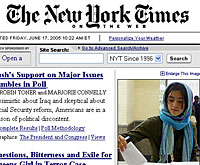 “A significant percentage of newspaper readers have transferred their preference from print to online editions,” said Davidson.
“A significant percentage of newspaper readers have transferred their preference from print to online editions,” said Davidson.
“Accordingly, many online editions now feature original content and have developed an online strategy that includes online message boards and editorial blogs, which leverage the medium’s strengths of interactivity and immediacy,” he added.
Yahoo and Google are both enjoying booming revenues, with cash rolling in from fast-growing Web search ads and a revival in traditional online advertising.
Although newspaper publishing revenue is growing slowly, it still remains stuck in an extended slump.
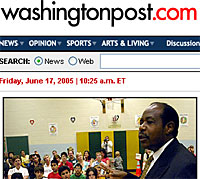 As traffic has increased traffic to news sites, newspaper editors have been allocating more content to their online editions, adding frequent news updates, weather news, original content, message boards and editorial blogs.
As traffic has increased traffic to news sites, newspaper editors have been allocating more content to their online editions, adding frequent news updates, weather news, original content, message boards and editorial blogs.
The New York Times Website, www.NYTimes.com, is ranked as the most visited site in the US, boasting an audience of 11.3 million in May – up 25 percent from last year, according to Nielsen//NetRatings.
Second in line is USATODAY.com, with an audience up 15 per cent to 9.2 million in May, followed by the washingtonpost.com, attracting an audience of 7.4 million, up 10 percent, year on year.
By comparison, Yahoo News registered a modem-busting online audience of 23.8 million, with Google lagging behind at 7.1 million, according to Nielsen//NetRatings.
The report observes that a greater proportion of blokes accessed newspapers primarily online, making up 53 percent of online readers, with the lay-dees preferring to read newspapers primarily in print.
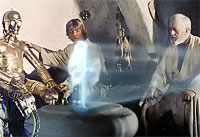 US scientists have created imaging technology that lets viewers enjoy what they claim to be the first truly three-dimensional holographic movies.
US scientists have created imaging technology that lets viewers enjoy what they claim to be the first truly three-dimensional holographic movies. Made by Texas Instruments, these clever puppies are currently used in television, video and movie projectors and incorporate a computer that processes an incoming digital signal several thousand times a second.
Made by Texas Instruments, these clever puppies are currently used in television, video and movie projectors and incorporate a computer that processes an incoming digital signal several thousand times a second. If you look at interferograms on a PC screen, all you get is a series of random black dots creating an effect that looks a bit like a telly on the blink.
If you look at interferograms on a PC screen, all you get is a series of random black dots creating an effect that looks a bit like a telly on the blink. Emerging blinking from their underground laboratories, the overworked boffins at Samsung have announced the creation of the SGH-E620 Bluetooth voice recognition phone which is a Bluetooth mobile with – you guessed it! – voice recognition technology.
Emerging blinking from their underground laboratories, the overworked boffins at Samsung have announced the creation of the SGH-E620 Bluetooth voice recognition phone which is a Bluetooth mobile with – you guessed it! – voice recognition technology. Vodafone has made their service more alluring to international business travellers by cutting roaming charges on their 3G data networks.
Vodafone has made their service more alluring to international business travellers by cutting roaming charges on their 3G data networks.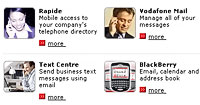 According to analysts Gartner, the new prices demonstrate that operators are currently charging too much; “This is a sign that mobile operators are starting to recognise they charge too much for roaming data services,” they added, as your writer’s head nodded vigorously in agreement (while making snarling noises in the direction of T-Mobile).
According to analysts Gartner, the new prices demonstrate that operators are currently charging too much; “This is a sign that mobile operators are starting to recognise they charge too much for roaming data services,” they added, as your writer’s head nodded vigorously in agreement (while making snarling noises in the direction of T-Mobile). Gartner noted that with Vodafone only selling sold 300,000 3G data cards since launching the 3G data network in January 2004, the company is hoping that the reduced roaming charges will boost this figure.
Gartner noted that with Vodafone only selling sold 300,000 3G data cards since launching the 3G data network in January 2004, the company is hoping that the reduced roaming charges will boost this figure. Apple and the Sundance Channel have signed a deal that will make content from the cable network exclusively available as podcast downloads from the Apple iTunes Web site next month, according to AdAge.
Apple and the Sundance Channel have signed a deal that will make content from the cable network exclusively available as podcast downloads from the Apple iTunes Web site next month, according to AdAge. One of the first iTunes podcast features scheduled for download from the Sundance Channel will be The Al Franken Show who is, apparently, an Air America talk show host.
One of the first iTunes podcast features scheduled for download from the Sundance Channel will be The Al Franken Show who is, apparently, an Air America talk show host.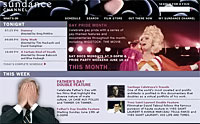 The feature in AdAge also reports that Sundance will receive Apple’s post-production editing equipment and expertise as part of the barter deal, with the two companies likely to collaborate on the Apple retail level in the future.
The feature in AdAge also reports that Sundance will receive Apple’s post-production editing equipment and expertise as part of the barter deal, with the two companies likely to collaborate on the Apple retail level in the future. In an interesting reversal of new media trends, online leisure retailer lastminute.com is to launch its first print magazine.
In an interesting reversal of new media trends, online leisure retailer lastminute.com is to launch its first print magazine. Not to be outdone, Brent Hoberman, chief executive of Lastminute.com, brewed up his own beefy brand of buzzword blather: “The launch of this magazine is a fantastic opportunity to engage with our most loyal customers and reinforce our brand values through inspirational and informative editorial.
Not to be outdone, Brent Hoberman, chief executive of Lastminute.com, brewed up his own beefy brand of buzzword blather: “The launch of this magazine is a fantastic opportunity to engage with our most loyal customers and reinforce our brand values through inspirational and informative editorial. After a long cuddle on the sofa, Napster and Ericsson have announced a global partnership to offer a fully integrated new digital music service aimed at mobile phone customers around the world.
After a long cuddle on the sofa, Napster and Ericsson have announced a global partnership to offer a fully integrated new digital music service aimed at mobile phone customers around the world. The two companies hope that their service will allow mobile operators to get their grubby mitts on the “growth opportunities for personalised digital entertainment on the mobile phone and PC” and will, no doubt, include the usual slew of lucrative, downloadable offerings like ringtones, master tones, images, wallpaper and video content.
The two companies hope that their service will allow mobile operators to get their grubby mitts on the “growth opportunities for personalised digital entertainment on the mobile phone and PC” and will, no doubt, include the usual slew of lucrative, downloadable offerings like ringtones, master tones, images, wallpaper and video content.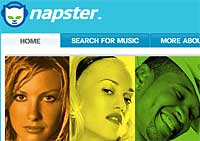 More and more mobile operators are already cutting themselves a slice of the mobile digital music services pie, with the largest Korean mobile phone operator recently purchasing a controlling stake in the country’s biggest record label.
More and more mobile operators are already cutting themselves a slice of the mobile digital music services pie, with the largest Korean mobile phone operator recently purchasing a controlling stake in the country’s biggest record label. Yahoo has whipped out its wallet and snapped up DialPad Communications, a company making VoIP software allowing users to make cut-price calls over the Internet.
Yahoo has whipped out its wallet and snapped up DialPad Communications, a company making VoIP software allowing users to make cut-price calls over the Internet. The company offers a selection of VoIP subscription plans to users – including prepaid VoIP calling cards – with charges ranging from as little as 1.7 cents per minute for calls to more than 200 countries.
The company offers a selection of VoIP subscription plans to users – including prepaid VoIP calling cards – with charges ranging from as little as 1.7 cents per minute for calls to more than 200 countries. In its announcement, Dialpad served up a bit more information about the deal: “Yahoo plans on leveraging Dialpad’s PSTN calling capabilities to add to Yahoo Messenger’s recently enhanced PC-to-PC voice calling offering. These products are very complementary and by combining our strengths, we are better positioned to take advantage of the fast growing IP telephony market and build a range of exciting new services.”
In its announcement, Dialpad served up a bit more information about the deal: “Yahoo plans on leveraging Dialpad’s PSTN calling capabilities to add to Yahoo Messenger’s recently enhanced PC-to-PC voice calling offering. These products are very complementary and by combining our strengths, we are better positioned to take advantage of the fast growing IP telephony market and build a range of exciting new services.” BT has unveiled a smarty-pants phone designed to integrate landline and mobile phone technologies.
BT has unveiled a smarty-pants phone designed to integrate landline and mobile phone technologies. BT Fusion is part of the company’s strategy to lure back customers wooed by mobile telephonic temptresses touting cheap calls.
BT Fusion is part of the company’s strategy to lure back customers wooed by mobile telephonic temptresses touting cheap calls. “The future will be convergence”, insisted Livingstone. “This is going to be a market that grows fantastically over time even though it might take a while to get going. We still expect many millions of converged handsets by the end of the decade.”
“The future will be convergence”, insisted Livingstone. “This is going to be a market that grows fantastically over time even though it might take a while to get going. We still expect many millions of converged handsets by the end of the decade.” Calls to landlines originating in the home will be ratcheted up at BT’s regular rate of 5.5 p (10 cents, €0.08) for up to an hour.
Calls to landlines originating in the home will be ratcheted up at BT’s regular rate of 5.5 p (10 cents, €0.08) for up to an hour.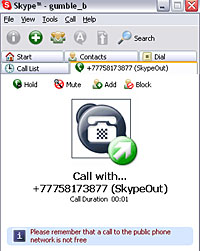 After several weeks in beta, Skype has officially launched the Skype Voicemail service, the company’s second pre-paid premium offering.
After several weeks in beta, Skype has officially launched the Skype Voicemail service, the company’s second pre-paid premium offering.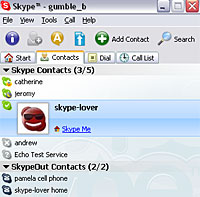 Skype v1.3 allows bolts on the ability to populate Skype contact lists from desktop applications including MSN, and auto-populate exact matches from Microsoft Outlook.
Skype v1.3 allows bolts on the ability to populate Skype contact lists from desktop applications including MSN, and auto-populate exact matches from Microsoft Outlook.